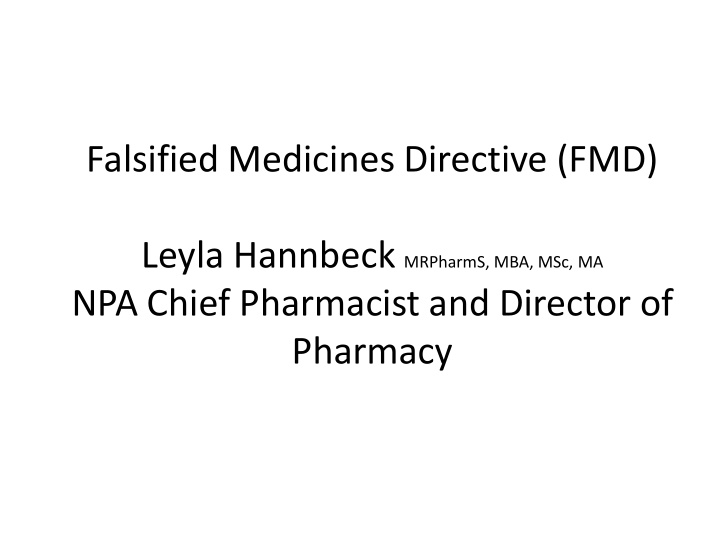



Falsified Medicines Directive (FMD) Leyla Hannbeck MRPharmS, MBA, MSc, MA NPA Chief Pharmacist and Director of Pharmacy
FMD: background Aims to prevent falsified medicines entering the supply chain • Approved by European Parliament • Two mandatory safety features • Allows medicines to be verified and authenticated • To be implemented from 9 February 2019 – The impact of Brexit is currently unknown
FMD: background • FMD requires : – Mandatory safety features on medicine packaging; an anti-tamper device (ATD) and unique identifier (UI) in the form of a 2D barcode – All online pharmacies register and display an EU wide logo – Restrictions on the import of active ingredients – Heightened record keeping requirements for wholesalers
FMD medicine safety features
Verifying and authenticating medicines Manufacturers enter each medicines UI code to the National Medicines Verification System (SecurMed UK) Pharmacies will be required to authenticate medicines “ at the time of supplying it to the public ” This includes checking the ATD is still intact And scanning the UI on the medicines outer packaging – referred to as ‘ decommissioning ’
Verifying and authenticating medicines • There are two potential messages displayed once the UI has been scanned: • Medicine can be dispensed as long as the ATD is undamaged “Active” • If the ATD is broken in order to dispense the medicine, this is exempt • Successfully decommissioned • Cannot be supplied “Inactive” • Additional messages include “already dispensed”, “recalled”, “withdrawn”, “stolen” or “locked”
Decommissioned medicines • Decommissioned medicine status change from: “Inactive – “Active” dispensed” wholesalers will verify the status of any product returned and any products with an “active” status will not be accepted • If the product is not supplied, the status can be reversed
Reversing the medicine status • Reversing the “ decommissioned ” status of a medicine can only occur if: – It takes place at the same pharmacy it was decommissioned – It occurs no more than 10 days after decommissioning – The product has not expired – The product has not been recalled, withdrawn, stolen or intended for destruction – The medicine has not been supplied to a patient
Enforcement and monitoring • Update legislation and set Department of Health penalties Medicines and Healthcare • Enforcement for manufacturers products Regulatory and wholesalers Agency (MHRA) General Pharmaceutical • Enforcement for community Council (GPhC) and Pharmaceutical Society of pharmacies Northern Ireland (PSNI)
Implications for pharmacy contractors • All community pharmacies will be required to: – Connect to the UK National Medicines Verification System – Update software – Obtain scanners – Introduce SOPs
Scanning and decommissioning medicines “ At the time of supplying it to the public ” is not defined but the FMD process must be completed before the medicine is released to the patient • ‘Aggregated barcodes’ may can be used where more than one medicine is dispensed – This code links multiple items together and allows decommissioning of all items in one go by scanning the aggregated code on the bag label • ‘10 day’ rule
Split packs and MDS • Check the ATD and scan UI when first opening a pack Split packs • Remainder of pack does not require further checks before use • Before dispensing into an MDS, ATDs must be checked and UI MDS scanned to decommission the product
Potential decommissioning points During assembly During accuracy check At point of hand out At point of hand out with aggregated code
FAQs
Do GSL and P medicines need to be decommissioned before supplying? • Non-prescription medicines are not included under FMD • Therefore do not require decommissioning – The only exception is OTC omeprazole • Unlicensed specials and appliances/devices do not require decommissioning
How do I deal with medicines that do not have a UI code? • There may be medicines in the supply chain which do not have a 2D barcode by February 2019 • These can still be dispensed • They are not required to be decommissioned
Who will pay for the additional equipment and training required? • Pharmacies will be responsible for any costs associated with obtaining or updating software and hardware • Total costs unknown
Recommend
More recommend